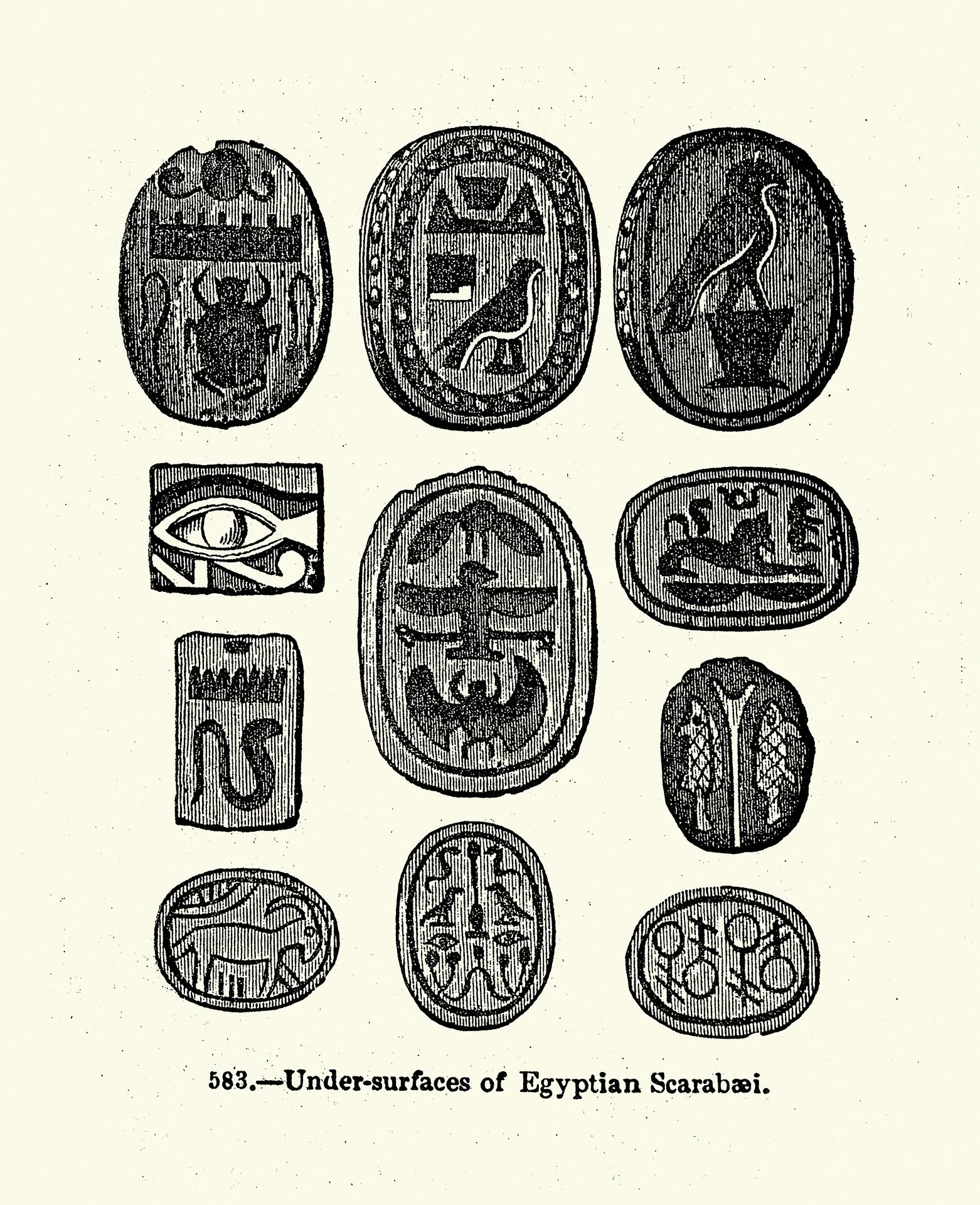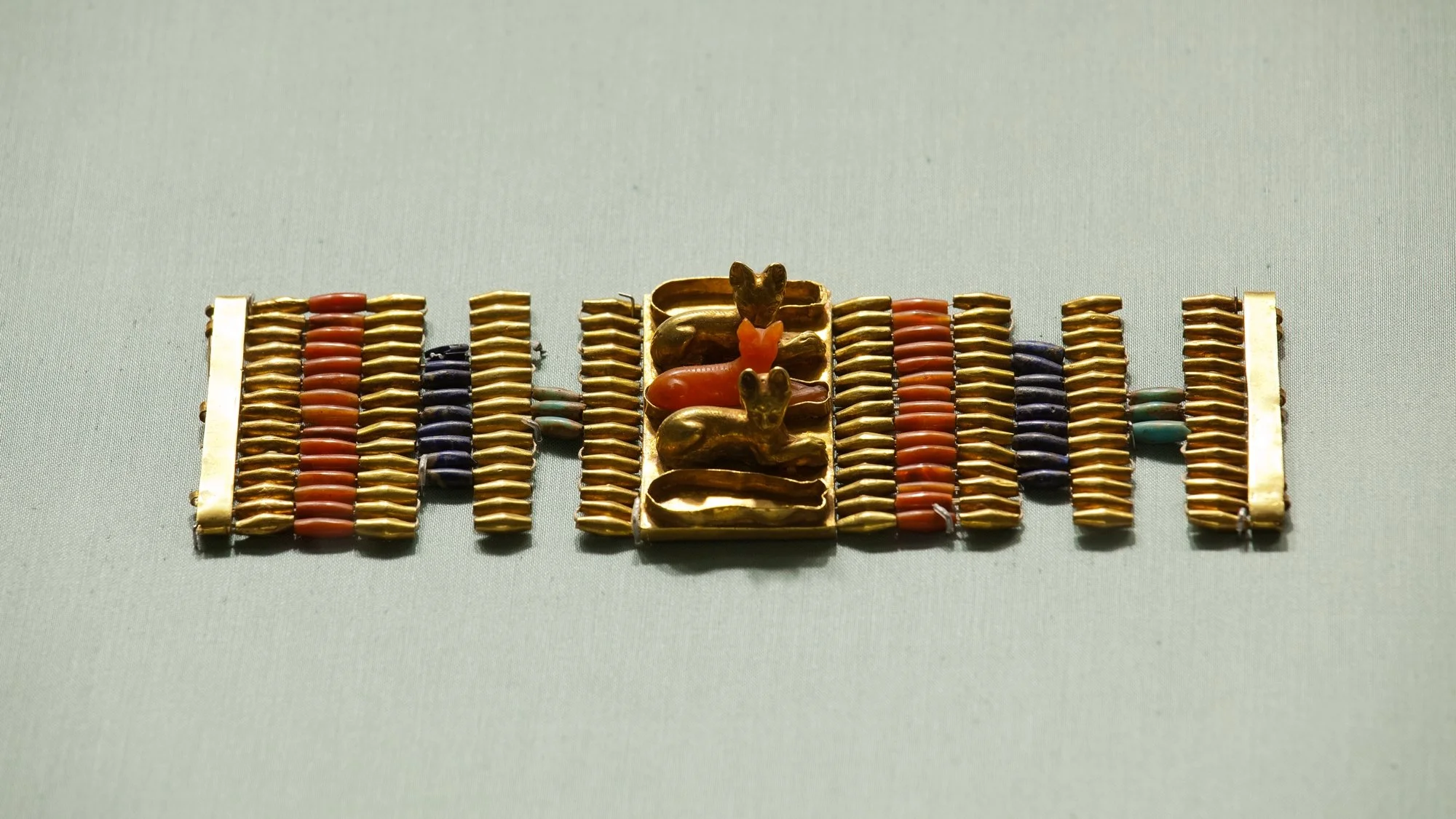Jewelry and Adornment: Ancient Egypt’s Love for Gold, Gems, and Amulets
Hello, fellow time travelers! We’ve covered beauty, makeup, and fragrance, but today, we’re getting even more glamorous—because it’s time to talk about ancient Egyptian jewelry and amulets!
If there’s one thing the ancient Egyptians knew how to do (besides build world-famous pyramids and master the art of the afterlife), it was accessorize. But jewelry wasn’t just about looking fabulous—it was a spiritual, social, and magical necessity. Whether dripping in gold or wearing a simple carved amulet, every piece had a deeper meaning, connecting the wearer to the gods, protection, and even eternal life.
Gold wasn’t just prized for its beauty; the Egyptians believed it was the flesh of the gods—literally divine. Lapis lazuli wasn’t just a pretty shade of blue; it represented the heavens and wisdom. Scarabs weren’t just trendy little beetle-shaped trinkets; they symbolized rebirth and transformation. Every ring, collar, and bracelet served a purpose beyond decoration, acting as a protective charm, a symbol of status, or even a key to the afterlife.
Amulets: Protection You Could Wear
For the ancient Egyptians, life could be unpredictable—sickness, bad luck, or even a rogue crocodile in the Nile. That’s where amulets came in. These tiny charms were more than just accessories; they were worn as magical armor, designed to protect, bless, and bring favor from the gods.
The scarab beetle was one of the most popular choices, symbolizing transformation and rebirth. People wore scarab-shaped pendants, engraved rings, and even carried them into the afterlife. Pharaohs, nobles, and everyday Egyptians alike placed their faith in the tiny beetle’s mystical ability to roll them safely into the next world—kind of like the world’s fanciest good luck charm.
Another favorite was the Eye of Horus—Egypt’s ancient answer to the evil eye. Thought to ward off misfortune and sickness, this sacred symbol was painted onto tomb walls, worn as jewelry, and even inscribed onto boats (because, let’s face it, no one wanted their boat cursed).
Then there was the ankh, a cross with a loop at the top, symbolizing eternal life. It was often carried by pharaohs, depicted in temple carvings, and worn as an amulet to ensure a smooth transition into the afterlife. Egyptians weren’t just planning for a long life—they were planning for a never-ending one.
Gold, Gemstones, and the Art of Looking Divine
If you were walking around ancient Egypt, your jewelry choices said a lot about you. Pharaohs, priests, and nobles draped themselves in gold collars, gemstone-studded cuffs, and elaborate rings. Gold wasn’t just for style—it was believed to be indestructible, like the gods themselves. The more gold you had, the closer you were to divine power.
Meanwhile, semi-precious stones weren’t just chosen for their beauty; they each had their own spiritual energy. Lapis lazuli, a deep blue stone, was associated with wisdom and the sky, while carnelian, a rich red-orange stone, was said to bring strength and energy. Turquoise was a symbol of health and protection, making it a common choice for jewelry worn both in life and into the tomb.
The most famous necklace in ancient Egypt was the broad collar, known as the usekh. This statement piece—crafted from rows of beads, gold, and inlaid gems—draped elegantly across the shoulders. Worn by pharaohs, queens, and high-ranking officials, it was a fashion statement, a protective shield, and a nod to divine favor all in one.
Bracelets, Rings, and the Art of Layering
Photo: Metropolitan Museum of Art
Stacking bracelets? The Egyptians were way ahead of us. Bangles, cuffs, and beaded bracelets were layered up the arms, often featuring protective spells, sacred carvings, or tiny amulets embedded within them.
Rings weren’t just for decoration—they often doubled as signet seals, used to stamp official documents and show authority. Many rings bore scarab beetles, cartouches with names inscribed, or intricate carvings of gods, ensuring that the wearer carried a bit of divine power wherever they went.
Even feet weren’t left out of the accessorizing game. Egyptians wore gold or leather sandals, some even inlaid with precious stones. And for those really dedicated to the look? Toe rings were a thing.
Jewelry for the Afterlife: Because Fashion Never Dies
In ancient Egypt, you didn’t just take your wealth with you to the grave—you were buried in it. Pharaohs and high-status individuals were entombed with layers of gold jewelry, protective amulets, and even bejeweled funeral masks.
King Tutankhamun’s famous burial revealed over 143 pieces of jewelry, all carefully arranged to ensure his safe passage and eternal reign in the afterlife. Funeral masks, like his iconic gold-and-lapis masterpiece, weren’t just for show—they were meant to preserve the soul and connect the deceased to the divine.
Many mummies were wrapped with heart scarabs, placed over the chest to ensure their heart wouldn’t betray them during the Weighing of the Heart ceremony. (No one wanted to fail that test and get fed to Ammit, the soul-devouring beast.) Others were adorned with golden ankhs, tiny Djed pillar amulets for stability, and engraved rings for protection.
Why Egyptian Jewelry Still Inspires Us Today
Photo Courtesy of Sotheby's
Ancient Egyptian jewelry wasn’t just about looking good—it was about feeling connected to something greater. Whether it was an offering to the gods, a mark of status, or a charm for good luck, every piece had meaning.
Even today, we see echoes of their designs everywhere. Gold cuffs, scarab charms, protective talismans, and statement necklaces still capture our imagination. The concept of wearing jewelry for both beauty and spiritual protection is just as relevant now as it was thousands of years ago.
Wrapping It Up
The Egyptians mastered the art of jewelry-making, turning every ring, necklace, and bracelet into a symbol of status, faith, and divine connection. Whether layering gold collars, carrying scarab rings for protection, or ensuring their afterlife jewelry game was strong, they truly knew how to accessorize for eternity.
And if you want to see these stunning artifacts in person, why not take a journey to the land that started it all? With Kemet Spiritual Journeys, you can explore the temples, museums, and tombs where these treasures were worn, buried, and admired for thousands of years.
Start planning your Egyptian adventure at kemetspiritualjourneys.com and step into the world of history’s most stylish civilization.





